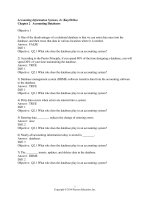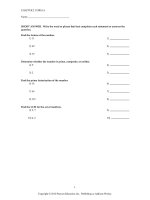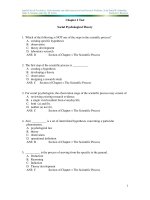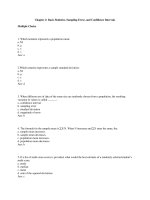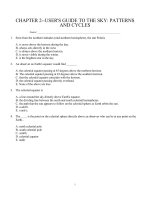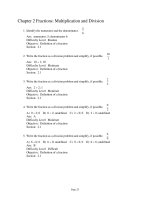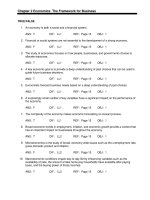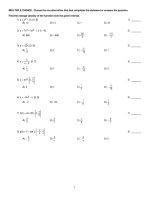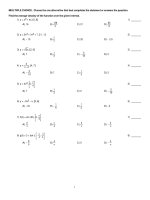Cultural ANTHRO 2nd edition robbins test bank
Bạn đang xem bản rút gọn của tài liệu. Xem và tải ngay bản đầy đủ của tài liệu tại đây (486.72 KB, 11 trang )
Chapter 2
The Meaning of Progress and Development
Multiple Choice Questions
1.
Until approximately ten thousand years ago most people lived in:
a) settled clans defined by common ancestors, usually male.
b) nomadic groups of around 30 to 100 people.
c) small-scale sedentary groups that practiced slash and burn agriculture.
d) sedentary communities of 1,000 to 10,000 people.
ANS: B
2.
SOURCE: Pickup
TOP: Question 2.1
PG: 30
LO: Fact
SOURCE: New
TOP: Question 2.1
PG: 30
LO: Fact
SOURCE: Pickup
The best way to describe the lack of inequality and class among hunter-gatherers
is to say they are:
a) unstratified
b) egalitarian
c) class-free
d) equivalent
ANS: B
5.
LO: Fact
The main organizing principle of hunting/gathering societies was:
a) class.
b) agricultural production.
c) kinship.
d) language.
ANS: C
4.
PG: 29
In hunter-gatherer societies specific occupational specialization was based on:
a) age.
b) spiritual powers.
c) Special training.
d) Family ties.
ANS: C
3.
TOP: Question 2.1
TOP: Question 2.1
PG: 30
LO: Applied
SOURCE: New
The three stages that Lewis Henry Morgan believed human societies evolved
through are:
a) nomadism, agriculturalism, and industrialism.
b) nomadism, sedentism, and agriculturalism.
c) savagery, barbarism, and civilization.
d) savagery, nomadism, and sedentism.
10
ANS: C
6.
TOP: Question 2.1A
PG: 32
LO: Fact
SOURCE: Pickup
TOP: Question 2.1A
PG: 32
LO: Fact
SOURCE: Pickup
TOP: Question 2.1B
PG: 34
LO: Fact
SOURCE: Pickup
According to James Woodburn, the Hadza people of Tanzania spend about how
many hours a day obtaining food?
a) 2 hours
b) 7 hours
c) 12 hours
d) 18 hours
ANS: A
10.
SOURCE: Pickup
The Ju/Wasi's major food source at the time of Richard Lee's study was:
a) grains.
b) elephant meat.
c) mongongo nuts.
d) fish.
ANS: C
9.
LO: Fact
What is a common American view of the relationship between technology and
progress?
a) Progress is measured by the extent to which a society borrows from other
societies.
b) Progress is best signaled by strong social control over how technology is
used.
c) Technology is the best measure of progress.
d) Technology and progress have no necessary relationship.
ANS: C
8.
PG: 32
According to Leslie White, what is the key factor in judging the relative
development of a particular culture?
a) The relative efficiency of the technology used to meet people’s needs.
b) The material wealth generated by a given society.
c) The extent to which equity is prevalent in a society.
d) The extent to which technology is used to produce non-essential products
such as art.
ANS: A
7.
TOP: Question 2.1A
TOP: Question 2.1B
PG: 33
LO: Fact
SOURCE: Pickup
In his research, Richard Lee found that all of the following describe the Ju/Wasi
diet EXCEPT:
a) It consisted of 2,300 calories daily on average.
11
b) It was vegetable based, although with a surprising amount of meat.
c) It lacked vitamin C and calcium.
d) It was low in carbohydrates.
ANS: D
11.
PG: 33-34 LO: Fact
SOURCE: Pickup
Mark Cohen argues that the main reason for groups to adopt agriculture was:
a) the failure of hunter-gatherers to have a balanced diet.
b) increased population density, a direct result of the success of hunter-gather
communities.
c) increased conflicts with other groups.
d) a decision on the part of leaders to claim land.
ANS: B
12.
TOP: Question 2.1B
TOP: Question 2.1C
PG: 35-36 LO: Fact
SOURCE: Pickup
“Slash and burn” agriculture is also known as:
a) settled agricultural production.
b) traditional agriculture.
c) pre-industrial agriculture.
d) swidden agriculture.
ANS: C
TOP: Question 2.1C
PG: 35-36 LO: Fact
SOURCE: Pickup
13. Switching from slash and burn agriculture to irrigation agriculture requires how
much more labor for the same harvest?
a) Three times as much.
b) Five times as much.
c) It actually requires the same amount of labor.
d) Ten times as much.
ANS: D
14.
PG: 36
LO: Fact
SOURCE: New
What factors limit slash and burn agriculture?
a) It is efficient only in temperate zones.
b) It is efficient only in places with heavy rainfall.
c) It is efficient only when population levels are constant.
d) It is efficient only with appropriate forms of technology.
ANS: C
15.
TOP: Question 2.1C
TOP: Question 2.1C
PG: 35-36 LO: Fact
SOURCE: Pickup
Complex agriculture is said to be more efficient due to less human energy but
this argument leaves out:
a) The kinds of crops that are grown.
b) The prices of the crops produced.
12
c) The greater non-human energy inputs.
d) The role of climate and weather.
ANS: C
16.
TOP: Question 2.1D
PG: 38
LO: Fact
SOURCE: Pickup
TOP: Question 2.2A
PG: 39
LO: Fact
SOURCE: New
TOP: Question 2.2B
PG: 40-41 LO: Fact
SOURCE: Pickup
The U.S. cotton industry in the 19th century led to:
a) the related production of livestock feed.
b) the movement of 835,000 slaves to different parts of the South.
c) the use of Native American farm workers.
d) the growth of new planting methods to improve cotton production.
ANS: B
20.
SOURCE: New
The British East India Company gain control of the textile market in India
through:
a) a combination of war, plunder, and competitive restrictions.
b) free market competition.
c) mergers with its Indian competitors.
d) production of superior cloth at lower prices.
ANS: A
19.
LO: Fact
Because 18th century English textile factories required new forms of social
control they were set up like:
a) traditional monasteries.
b) farmsteads.
c) marketplaces and stores.
d) workhouses and prisons.
ANS: D
18.
PG: 37
Approximately what percentage of potatoes grown in the United States are
processed into products like chips and instant mashed potatoes?
a) 10 percent
b) 30 percent
c) 50 percent
d) 75 percent
ANS: C
17.
TOP: Question 2.1C
TOP: Question 2.2C
PG: 40-41 LO: Fact
SOURCE: New
What do theories about economic development NOT assume?
a) That economic growth can solve national problems.
b) That economic growth will provide social equity.
c) That global economic integration will help all countries.
13
d) That foreign aid to less developed countries will lead to better lives for the
citizens of these countries.
ANS: B
21.
TOP: Question 2.3A
PG: 43-47 LO: Fact
SOURCE: New
TOP: Question 2.4B
PG: 49-50 LO: Fact
SOURCE: Pickup
TOP: Question 2.4A
PG: 48
LO: Fact
SOURCE: New
Which type of population is more likely to increase the spread of an infectious
disease?
a) A small and scattered population
b) People in a highly developed society
c) A relatively large, dense, and permanent settlement.
d) A technologically advanced population
ANS: C
25.
SOURCE: Pickup
Poverty contributes to poor immune system health because the poor:
a) have inadequate diets.
b) are under great stress.
c) cannot afford medical care.
d) live in unsanitary conditions.
ANS: A
24.
LO: Fact
The disease syndrome called susto usually is found in:
a) Africa.
b) Latin America.
c) the United States.
d) China.
ANS: B
23.
PG: 43
The institution that made loans to poor countries for economic development
was:
a) The United Nations.
b) The World Bank.
c) The Structural Adjustment Program.
d) The International Monetary Fund.
ANS: B
22.
TOP: Question 2.3A
TOP: Question 2.4A
PG: 48
LO: Fact
SOURCE: Pickup
According to Arthur Rubel, the condition known as susto only occurs when:
a) People experienced stress from social relations with specific people.
b) People have experienced a traumatic event.
c) People undergo stress caused by interacting with strangers.
d) People suffer the loss of a close family member.
14
ANS: A
26.
TOP: Question 2.4B
PG: 50
LO: Fact
SOURCE: Pickup
TOP: Question 2.5A
PG: 51-52 LO: Fact
SOURCE: Pickup
TOP: Question 2.5B
PG: 52-53 LO: Fact
SOURCE: Pickup
When communities and societies abandon hunting/gathering, they usually
become:
a) herders.
b) slash and burn farmers.
c) criminals.
d) small-scale laborers.
ANS: B
30.
SOURCE: Pickup
According to Jonathan Lear, what does it mean for a Crow warrior such as
Plenty Coups to state, “After this, nothing happened?”
a) Crow people do not understand clock time.
b) It is an example of traditional thinking.
c) The Crow experienced cultural devastation between 1851 and 1882.
d) He could not remember the early years of his life.
ANS: C
29.
LO: Fact
Which of the following societies was exterminated as a result of contact with
Europeans?
a) Inuit
b) Ju/Wasi
c) Ona
d) Cherokee
ANS: C
28.
PG: 50
Which of the following is NOT recognized as a cause of illness among the
Ndembu?
a) Viral infections
b) Ancestral ghosts
c) Magic
d) Social conflict
ANS: A
27.
TOP: Question 2.4B
TOP: Question 2.1C
PG: 36
LO: Fact
SOURCE: Pickup
Which of the below was NOT an example of the importance of war and raiding
among traditional Plains Indians?
a) Children derived their names from warriors’ exploits.
b) Societies conducted important corn-planting ceremonies.
c) Women displayed their husbands’ and sons’ war and raiding trophies.
15
d) Traditional religion was permeated with symbolism of raiding and war.
ANS: B
TOP: Question 2.5B
PG: 53
LO: Fact
SOURCE: New
True/False Questions
1. The Ju/Wasi people of Namibia have historically been malnourished because they
live in a harsh desert environment.
ANS: F
TOP: Question 2.1B
PG: 34
LO: Fact
SOURCE: Pickup
2. Settled agriculture developed as a necessary response to an increased population,
not because it was widely perceived as a better way of life.
ANS: T
TOP: Question 2.1C
PG: 35-36 LO: Fact
SOURCE: Pickup
3. Slash and burn agriculture remains efficient only as long as the population and the
amount of land available remain constant.
ANS: F
TOP: Question 2.1C
PG: 36
LO: Fact
SOURCE: Pickup
4. The amount of energy required to produce sufficient food supplies tends to increase
with advances in agricultural technology.
ANS: T
TOP: Question 2.1C
PG: 36-37 LO: Fact
SOURCE: Pickup
5. The strength of a person’s immune system is mainly determined by genetics.
ANS: F
TOP: Question 2.4A
PG: 48
LO: Fact
SOURCE: Pickup
6. The British East India Company was a joint venture between the Indian and British
governments.
ANS: F
TOP: Question 2.2B
PG: 40
LO: Fact
SOURCE: New
7. The growth of a cotton industry and the subsequent demand for slave labor in the
American South was driven by a combination of technological, economic, and political
reasons.
ANS: T
TOP: Question 2.2C
PG: 41-42 LO: Fact
SOURCE: Pickup
8. The World Bank was established as an agency of the League of Nations.
ANS: F
TOP: Question 2.3A
PG: 43
16
LO: Fact
SOURCE: Pickup
9. Access to good health care is more dependent upon a society’s degree of inequality
than its wealth.
ANS: T
TOP: Question 2.4A
PG: 48
LO: Fact
SOURCE: New
10. A pathogen is an infectious agent that can spread diseases.
ANS: T
TOP: Question 2.4A
PG: 48
LO: Fact
SOURCE: Pickup
11. The domestication of animals has played little part in the rise of human infectious
diseases.
ANS: F
TOP: Question 2.4A
PG: 48
LO: Fact
SOURCE: New
12. The Ndembu believe that an illness is caused by the consumption of ritually unclean
pork.
ANS: F
TOP: Question 2.4B
PG: 50-51 LO: Fact
SOURCE: Pickup
13. The interpersonal theory of disease assumes that illness is caused by tensions or
conflicts between different people.
ANS: T
TOP: Question 2.4B
PG: 50
LO: Fact
SOURCE: New
14. The "putting out" system in the English textile industry referred to weavers working
at home.
ANS: T
TOP: Question 2.2A
PG: 39
LO: Fact
SOURCE: Pickup
15. The Ona of Tierra del Fuego are a good example of how an indigenous population
can be successfully integrated into modernization and economic improvement.
ANS: F
TOP: Question 2.5A
PG: 51-52 LO: Fact
SOURCE: Pickup
Short Answer Questions
1. Compare and contrast the “necessary evil” and “progress” arguments for the shift
from hunter-gather modes of production to settled agricultural production.
ANS: Will vary TOP: Question 2.1
PG: 29-36 LO: Fact
SOURCE: Pickup
2. What other technological, social, and cultural factors appear with the rise of
irrigation agriculture? Why might this be so?
17
ANS: Will vary TOP: Question 2.1C
PG: 47-48 LO: Appl.
SOURCE: New
3. Why is the belief that people in hunter/gatherer societies have a harsh and
dangerous lifestyle ethnocentric?
ANS: Will vary TOP: Question 2.1B
PG: 33-35 LO: Fact
SOURCE: Pickup
4. What does Leslie White’s theory about the relationship between energy and cultural
development imply about the role of technology in social change?
ANS: Will vary TOP: Question 2.1A
PG: 32-33 LO: Fact
SOURCE: Pickup
5. What is the key difference between an interpersonal theory of disease and a biomedical theory of disease?
ANS: Will vary TOP: Question 2.4B
PG: 48-50 LO: Fact
SOURCE: Pickup
6. Describe the shared characteristics of susto as described by the anthropologist Arthur
Rubel.
ANS: Will vary TOP: Question 2.4B
PG: 49-50 LO: Fact
SOURCE: Pickup
7. Explain the relationship between diet, personal wealth, and susceptibility to
infectious diseases.
ANS: Will vary TOP: Question 2.4A
PG: 48
LO: Fact
SOURCE: Pickup
8. There are numerous ways that complex societies create conditions conducive to the
spread of disease and the survival of microorganisms. Name at least four of these
conditions that are created.
ANS: Will vary TOP: Question 2.4A
PG: 47-48 LO: Fact
SOURCE: Pickup
9. How do the Ndembu people of Zambia treat disease?
ANS: Will vary TOP: Question 2.4B
PG: 50
LO: Fact
SOURCE: Pickup
10. What are the four things that must happen for someone to die of infectious disease?
ANS: Will vary TOP: Question 2.4A
PG: 48
LO: Fact
SOURCE: New
11. Compare the amount of human and non-human energy that goes into agricultural
production in New Guinea as opposed to the United States. Which system is more
efficient, and why?
18
ANS: Will vary TOP: Question 2.1D
PG: 37-38 LO: Fact
SOURCE: Pickup
12. Describe the historical development of the British textile industry. How did this
industry change British society?
ANS: Will vary TOP: Question 2.2A
PG: 39-40 LO: Fact
SOURCE: New
13. What were the three characteristics of “economic development” as described by
President Harry Truman? What ethnocentric assumptions might be identified in
these characteristics?
ANS: Will vary TOP: Question 2.3A
PG: 43-44 LO: Fact
SOURCE: New
14. What tactics adapted by the Crow people enabled them to survive as a society in the
face of cultural devastation?
ANS: Will vary TOP: Question 2.5B
PG: 52-54 LO: Fact
SOURCE: Pickup
15. What medical and political factors contributed to the extermination of the Ona
people, who once inhabited the island of Tierra del Fuego?
ANS: Will vary TOP: Question 2.5A
PG: 51-52 LO: Fact
SOURCE: Pickup
Essay Questions
1. Susto in Latin America is brought on by a fright or sudden encounter. Symptoms
include restlessness, listlessness, and a loss of appetite. Discuss how healers treat
these symptoms and explain how this traditional cure could work without modern
medicine.
ANS: Will vary
PG: 49-50
LO: Fact
SOURCE: Pickup
2. Soul loss, spirit possession, sorcery, and witchcraft are all expressions of the
interpersonal theory of disease. Explain how these traditional theories of illnesses
are expressions of interpersonal theories of disease and how patients could be
treated by traditional healers.
ANS: Will vary
PG: 49-50
LO: Applied
SOURCE: Pickup
3. In India and Nepal, towns and people reacted very differently to the introduction of
latrines and toilets. Identify the different factors that contributed to these
reactions. How could the successful case (Nepal) inform the unsuccessful
one(India)?
19
ANS: Will vary
PG: 44-45
LO: Conceptual
SOURCE: New
4. In the text, debt is described as a form of “neocolonialism.” Explain how debt
functions in this way. Identify the different institutions contributing to the rise of
indebted nations. How does this debt make such nations vulnerable to
“neocolonialism”?
ANS: Will vary
PG: 46-47
LO: Applied
SOURCE: Pickup
5. What is the “meaning” of illness for most Americans? How might Americans apply
an “interpersonal theory of disease” to their own society? What could this tell us
about U.S. culture more generally?
ANS: Will vary
PG: 49-50
LO: Conceptual
SOURCE: New
6. Consider the story of Plenty Coups. How did he use his own cultural understanding
to resolve the conflicts he felt about the destruction of his culture? Identify
examples of this and suggest whether a similar experience of “radical hope” could
help us understand the changes in our own society.
ANS: Will vary
PG: 37-38
LO: Applied
20
SOURCE: New
